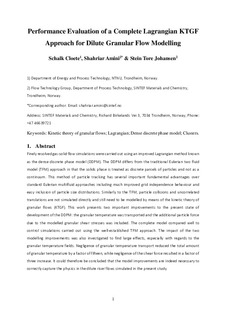| dc.contributor.author | Cloete, Schalk | |
| dc.contributor.author | Johansen, Stein Tore | |
| dc.contributor.author | Amini, Shahriar | |
| dc.date.accessioned | 2017-12-04T10:11:05Z | |
| dc.date.available | 2017-12-04T10:11:05Z | |
| dc.date.created | 2012-09-24T15:34:11Z | |
| dc.date.issued | 2012 | |
| dc.identifier.citation | Powder Technology. 2012, 226 43-52. | nb_NO |
| dc.identifier.issn | 0032-5910 | |
| dc.identifier.uri | http://hdl.handle.net/11250/2468952 | |
| dc.description.abstract | Finely resolved gas–solid flow simulations were carried out using an improved Lagrangian method known as the dense discrete phase model (DDPM). The DDPM differs from the traditional Eulerian two fluid model (TFM) approach in that the solids phase is treated as discrete parcels of particles and not as a continuum. This method of particle tracking has several important fundamental advantages over standard Eulerian multifluid approaches including the much improved grid independence behaviour and easy inclusion of particle size distributions. Similarly to the TFM, particle collisions and uncorrelated translations are not simulated directly and still need to be modelled by means of the kinetic theory of granular flows (KTGF). This work presents two important improvements to the present state of development of the DDPM: the granular temperature was transported and the additional particle force due to the modelled granular shear stresses was included. The complete model compared well to control simulations carried out using the well-established TFM approach. The impact of the two modelling improvements was also investigated to find large effects, especially with regard to the granular temperature fields. Negligence of granular temperature transport reduced the total amount of granular temperature by a factor of fifteen, while negligence of the shear force resulted in a factor of three increase. It could therefore be concluded that the model improvements are indeed necessary to correctly capture the physics in the dilute riser flows simulated in the present study. | nb_NO |
| dc.language.iso | eng | nb_NO |
| dc.publisher | Elsevier | nb_NO |
| dc.rights | Attribution-NonCommercial-NoDerivatives 4.0 Internasjonal | * |
| dc.rights.uri | http://creativecommons.org/licenses/by-nc-nd/4.0/deed.no | * |
| dc.title | Performance evaluation of a complete Lagrangian KTGF approach for dilute granular flow modelling | nb_NO |
| dc.type | Journal article | nb_NO |
| dc.type | Peer reviewed | nb_NO |
| dc.description.version | acceptedVersion | nb_NO |
| dc.source.pagenumber | 43-52 | nb_NO |
| dc.source.volume | 226 | nb_NO |
| dc.source.journal | Powder Technology | nb_NO |
| dc.identifier.doi | 10.1016/j.powtec.2012.04.010 | |
| dc.identifier.cristin | 946214 | |
| dc.relation.project | Norges forskningsråd: 197580 | nb_NO |
| dc.description.localcode | © 2012. This is the authors’ accepted and refereed manuscript to the article. This manuscript version is made available under the CC-BY-NC-ND 4.0 license http://creativecommons.org/licenses/by-nc-nd/4.0/ | nb_NO |
| cristin.unitcode | 194,64,25,0 | |
| cristin.unitname | Institutt for energi- og prosessteknikk | |
| cristin.ispublished | true | |
| cristin.fulltext | postprint | |
| cristin.qualitycode | 1 | |

